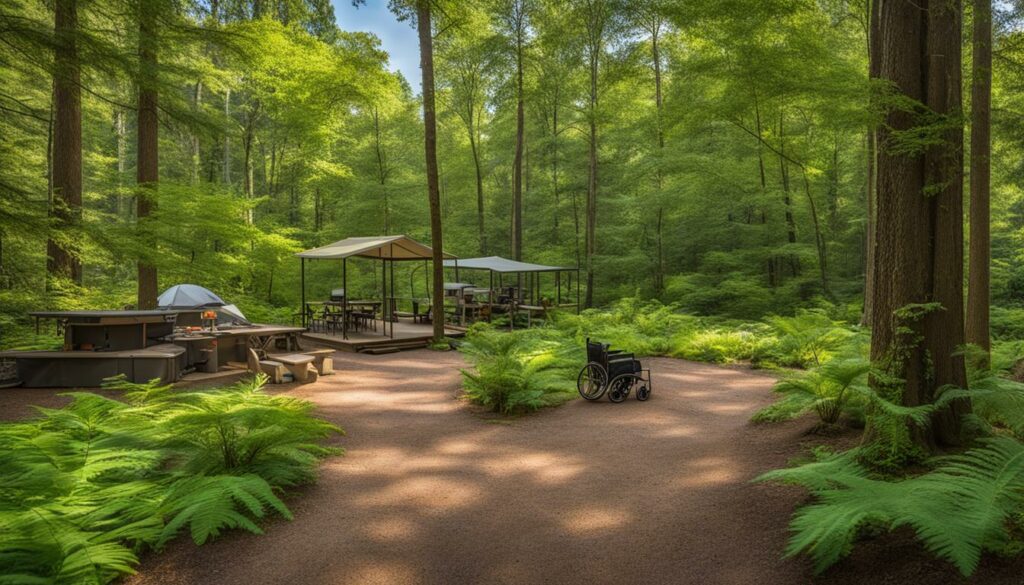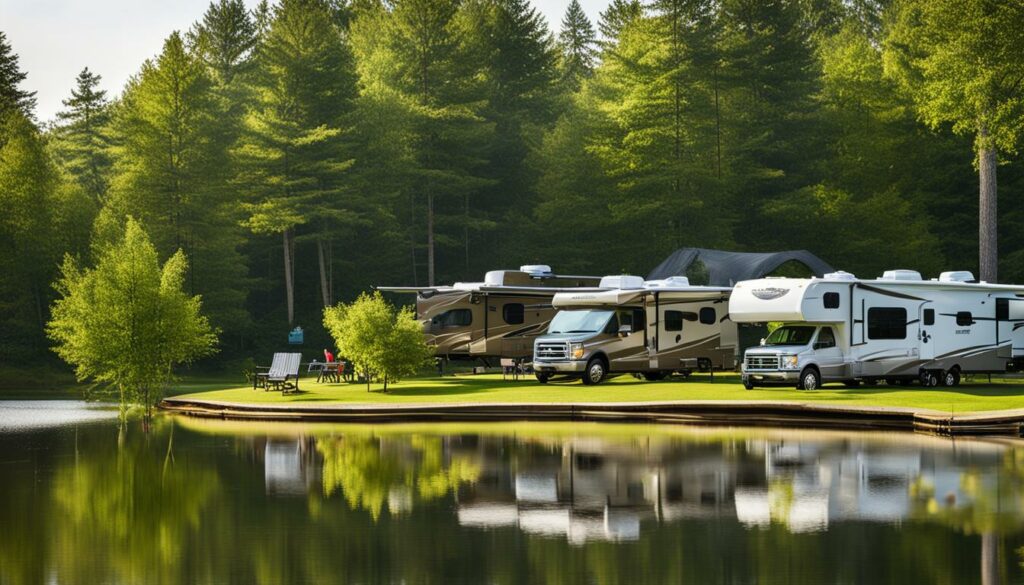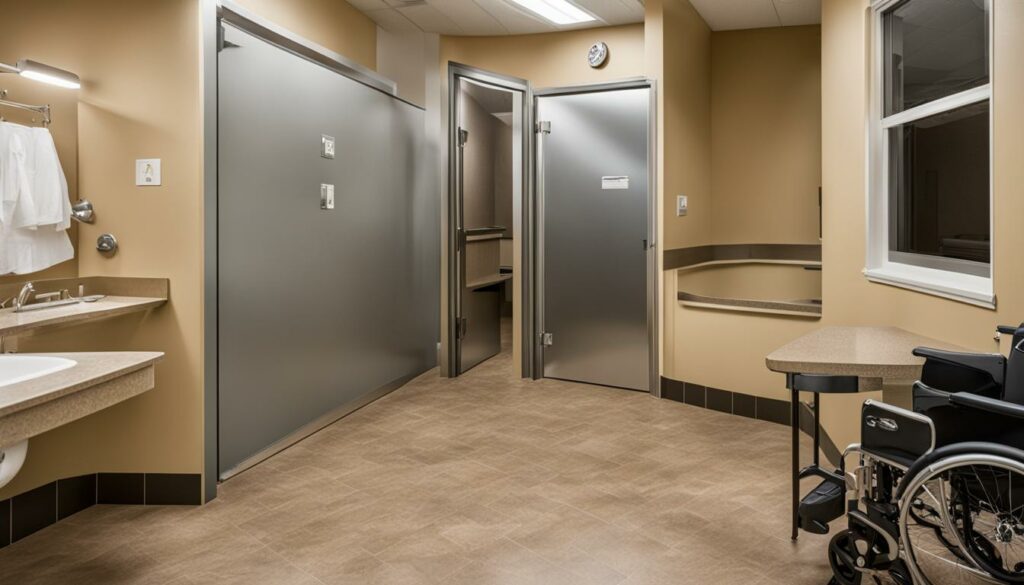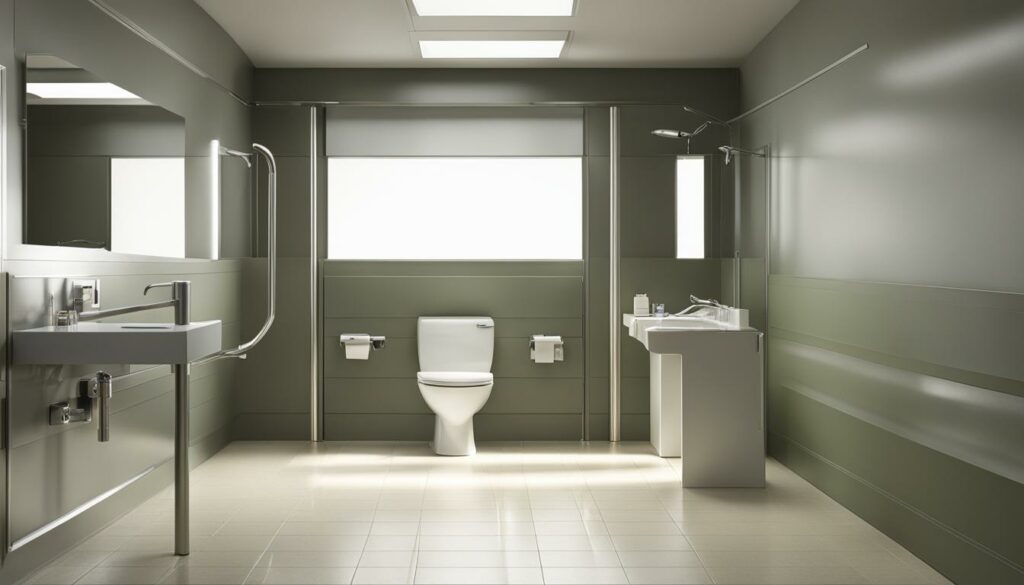Welcome to this comprehensive guide to installing accessible bathroom facilities in campgrounds. As we know, creating a safe and welcoming environment for all visitors is a top priority for campground owners and managers. It is imperative to ensure that your campground is ADA compliant and inclusive.
Having accessible bathroom facilities is an essential aspect of every inclusive campground, but unfortunately, this is not always the case. This guide is designed to provide you with a step-by-step approach to designing and implementing accessible bathroom facilities in your campground. You will learn how to assess your current facilities, design accessible bathrooms, choose ADA compliant accessories, and promote inclusivity by educating staff and campers.
We aim to help you create a barrier-free environment that will make your campground accessible to everyone. Read on to learn how to make your campground more inclusive and welcoming to all visitors, regardless of ability.
Key Takeaways
- A barrier-free environment is essential for creating an inclusive and welcoming campground for all visitors.
- Accessible bathroom facilities are a crucial aspect of ensuring ADA compliance and inclusivity in campgrounds.
- Assessing your current facilities is essential before embarking on any renovation or upgrade project.
- Design and layout considerations, ADA compliant accessories, and hiring professional contractors are critical aspects of creating accessible bathrooms.
- Educating staff and campers about accessibility will help promote inclusivity and ensure all visitors feel welcome.
Understanding Accessibility Requirements for Campgrounds

Ensuring accessibility and inclusion is crucial when designing campground facilities. It promotes equal access for individuals of all abilities and creates a more welcoming environment for everyone. This section will highlight the essential accessibility requirements for campgrounds, including:
- Wheelchair Accessible Campgrounds: Campgrounds must have wheelchair accessible routes throughout the park, including camping sites, amenities, and restrooms.
- ADA Compliant Campgrounds: Campgrounds must comply with the Americans with Disabilities Act (ADA) regulations, which set standards for accessibility requirements, such as parking spaces, pathways, and bathroom facilities.
- Barrier-Free Campgrounds: Campgrounds must create a barrier-free environment, meaning that individuals with disabilities can access all areas without hindrance or obstacles.
Designing accessible campground facilities is not only a legal requirement but also makes good business sense. It enables campground owners to expand their customer base and cater to the needs of all visitors. By prioritizing accessibility in their facilities, campgrounds can serve as a model for other industries and promote a more inclusive society.
“Providing accessible camping facilities is not only a legal requirement but also makes good business sense.”
Assessing Your Current Bathroom Facilities

Creating accessible camping facilities requires a detailed assessment of your current bathroom amenities.
Start by looking for any physical barriers that prevent users from reaching the restroom. Entryways should have a minimum of 32 inches of clearance while the bathroom door should be at least 36 inches wide. Ensure that the pathway leading to the bathroom has a firm and stable surface that is not slippery or spongy. The pathway should also have a minimum width of 36 inches, with a clearance height of 80 inches.
Pro Tip: Install an automatic door opener with a button installed below 34 inches to allow easy entry of wheelchair users.
Inside the restroom, check for any sharp edges or corners, especially for grab rails, sinks or counters. All edges and corners must be rounded to avoid any potential injuries to users. Countertops should have adequate space underneath allowing wheelchair users to access sinks and mirrors.
Pro Tip: Install shock-absorbing guards or pads on corners if they are not rounded to provide maximum safety for all users.
| Feature | How to Analyze |
|---|---|
| Grab Bars | Check for proper installation, location, and sturdiness. Are they accessible and able to support the weight of users? Grab bars should be located 33-36 inches from the floor and be no more than 1.25 inches in diameter. |
| Toilet Height and Clearance | The standard toilet height is 17-19 inches. Ensure that there is a clearance of at least 48 inches in front of toilets and not less than 36 inches in width. Check for any obstruction that may cause harm to a user’s legs or knee. |
| Signage | Check for accessible and visible signs, including Braille equivalents for users with visual impairments. Signs should be located no more than 60 inches and no less than 48 inches from the floor. |
For campgrounds aiming for ADA compliance, it is essential to assess all bathroom amenities and make necessary improvements. Providing accessible amenities in campgrounds will not only benefit users but also promote inclusivity and diversity in your campground community.
Designing Accessible Bathrooms

Designing accessible restrooms in campgrounds requires careful consideration of various features to ensure they meet ADA accessibility guidelines. The layout, fixtures, grab bars, and signage are essential components of a well-designed accessible restroom.
Starting with the layout, it is essential to create adequate space for maneuvering a wheelchair comfortably. ADA guidelines require that the minimum clear floor space inside a restroom is 60 inches in diameter.
When choosing the fixtures for an accessible restroom, it is essential to consider their placement and height carefully. All fixtures, including sinks, faucets, and soap dispensers, should be within reach of a person using a wheelchair.
Grab bars are a vital feature in accessible restrooms, providing support and stability for individuals with mobility challenges. ADA guidelines recommend horizontal grab bars on the rear and side walls of toilet facilities and vertical grab bars behind the toilet and on the walls next to it.
Signage is an important consideration for accessible restrooms in campgrounds. ADA guidelines require that restrooms have signage with high contrast, easy-to-read letters, tactile characters, and raised symbols. The signage must also be mounted on the door at specific heights consistent with ADA regulations.
By taking these design considerations into account, campground owners can ensure that their accessible restrooms meet the necessary ADA accessibility guidelines and make camping more accessible for individuals with disabilities.
Ensuring Accessible Showers in Campgrounds
Campgrounds must have accessible shower facilities that cater to all visitors, including those with disabilities. This can be achieved by installing roll-in showers, adjustable showerheads, benches, and grab bars. Roll-in showers should have a minimum clear opening of 36 inches, while adjustable showerheads must be handheld with a hose at least 60 inches long to accommodate users of different heights and abilities.
Benches should be at least 20 inches deep and 17 inches high, offering ample support and comfort for users. Grab bars should be located adjacent to the shower bench and at the entry and exit points of the shower. They should be sturdy enough to support up to 250 pounds of weight and placed in a horizontal or diagonal position, ensuring easy access for users.
“Accessible showers are not only essential for ADA compliance but are also a reflection of our commitment to creating inclusive campgrounds that cater to the diverse needs of all visitors.”
Choosing ADA Compliant Bathroom Accessories

To ensure a campground is ADA compliant, it’s important to select the right bathroom accessories. This includes items like toilet seats, sinks, faucets, and hand dryers. By choosing accessories that meet ADA guidelines, campground owners can ensure all visitors have access to the facilities they need.
When selecting bathroom accessories for an ADA compliant campground, consider the following:
Height and Clearance
Accessories such as toilets, sinks, and hand dryers should be installed at a height that is easily reached by all visitors. Clearances around these fixtures should also allow for unobstructed use by individuals with disabilities, particularly those using mobility aids such as wheelchairs. The appropriate heights and clearances for each accessory can be found in the ADA Standards for Accessible Design.
Operation and Controls
Choose accessories that are easy to operate, with controls that require minimal strength or dexterity. For example, faucets with lever handles or touch-free sensors are more accessible than those with knobs that require twisting. Toilet flush levers should be no higher than 44 inches from the floor and require no more than 5 pounds of force to operate.
Accessibility Features
Some accessories come with built-in accessibility features, such as grab bars or raised toilet seats. When feasible, it’s recommended to choose accessories with these features to make the campground facilities more inclusive. For example, installing grab bars around toilets can make them easier to use for individuals with mobility limitations.
By selecting the right bathroom accessories, campground owners can make their facilities more accessible for all visitors. Remember to always refer to the ADA Standards for Accessible Design to ensure that all accessories meet the appropriate guidelines for an ADA compliant campground.
Hiring Professional Contractors for Renovation
When renovating bathroom facilities in campgrounds to meet ADA compliance and accessibility requirements, it is essential to work with professional contractors who have the necessary experience and knowledge to complete the job correctly. It is not only a legal requirement but also an ethical responsibility to ensure that all visitors have access to comfortable and inclusive bathroom facilities.
When searching for contractors who specialize in creating accessible bathrooms in campgrounds, it is advisable to ask for recommendations and conduct background checks to ensure that they have a good reputation. Consider working with contractors who have experience in designing accessible bathrooms and can provide a portfolio of their previous work to demonstrate their expertise.
When communicating with potential contractors, ensure that they are familiar with the specific accessibility requirements for campgrounds and can provide guidance on how to meet them. Additionally, discuss your budget and timeline upfront, and ensure that the contractor can work within your constraints. It is also critical to check whether they are licensed and insured to avoid any liabilities and legal issues.
An experienced and professional contractor can provide valuable insights and advice on the design, layout, and installation of accessible bathroom facilities in campgrounds. They can ensure that the bathrooms meet all accessibility requirements, are efficient and cost-effective, and can provide long-term benefits for campground visitors.
Educating Staff and Campers about Accessibility
Ensuring accessible camping facilities and handicap accessible campgrounds is only the first step in promoting inclusivity – educating staff and campers about accessibility is just as crucial. Education can help to dispel misconceptions, raise awareness, and promote positive attitudes toward disability.
Campground owners and managers should provide training to staff on disability etiquette, accessibility features, and responding to disability-related requests. This training can help to ensure that staff members are prepared to provide the necessary accommodations and support to campers with disabilities.
Campers should also be educated about accessibility and disability etiquette. This can be done through resources such as brochures, websites, and signs, as well as community building events that promote diversity and inclusivity. By fostering a culture of understanding and respect, campgrounds can create a welcoming and inclusive environment for all visitors.
“Accessibility is not a privilege – it is a right. By educating staff and campers about accessibility, we can create a more accepting and inclusive environment for people with disabilities.”
Conclusion
Installing accessible bathroom facilities in campgrounds is not only a legal requirement for ADA compliance, but it is also a necessary step in creating inclusive and welcoming camping facilities. Campground owners and managers must prioritize accessibility to ensure that all visitors, including those with disabilities, can enjoy the great outdoors.
By understanding accessibility requirements, assessing current facilities, designing accessible bathrooms and showers, choosing ADA compliant accessories, and hiring professional contractors for renovations, campground owners and managers can take concrete steps to improve accessibility in their facilities.
It is also crucial to educate staff and campers about accessibility to ensure that everyone is aware of the importance of accessibility and the efforts being made to promote inclusivity in campgrounds.
Investing in accessible bathroom facilities is a smart move for campground owners and managers, as it not only helps to meet legal requirements but also provides a better experience for all visitors. Accessible camping facilities, including accessible bathroom facilities, wheelchair accessible campgrounds, and ADA compliant campgrounds, are essential to make camping enjoyable for everyone.
FAQ
What are the benefits of installing accessible bathroom facilities in campgrounds?
Installing accessible bathroom facilities in campgrounds has several benefits. It ensures compliance with ADA regulations, making the campground accessible for people with disabilities. It also promotes inclusivity, providing equal opportunities for all campers to enjoy their stay. Additionally, accessible facilities improve the overall camping experience and contribute to positive reviews and word-of-mouth recommendations.
What are the accessibility requirements for campgrounds?
Campgrounds need to meet specific accessibility requirements to ensure wheelchair accessibility and ADA compliance. This includes providing accessible parking spaces, level and firm pathways throughout the campground, accessible campsites, and accessible bathroom and shower facilities. These requirements aim to make campgrounds barrier-free and accessible for all individuals.
How can I assess the accessibility of my current bathroom facilities in a campground?
To assess the accessibility of your current bathroom facilities, conduct a thorough evaluation using a checklist. Look for features such as widened doorways, grab bars, accessible sinks, toilets, and showers, non-slip flooring, and appropriate signage. Consider consulting an accessibility expert or conducting an accessibility audit to ensure a comprehensive assessment.
What design considerations should I keep in mind when creating accessible bathrooms in campgrounds?
When designing accessible bathrooms in campgrounds, consider the layout to allow easy maneuverability for wheelchair users. Install grab bars near toilets, sinks, and showers for support and balance. Ensure sinks and toilets have appropriate clearance for wheelchair access. Use contrasting colors and clear signage for visibility, and choose non-slip flooring materials for safety.
What features should I include in accessible shower facilities in campgrounds?
Accessible shower facilities should include features such as roll-in showers with no threshold, adjustable showerheads, grab bars for stability, built-in benches or fold-down seats, and non-slip flooring. Additionally, ensure there is ample space within the shower area for wheelchair users to maneuver comfortably.
Why is choosing ADA compliant bathroom accessories important for campgrounds?
Choosing ADA compliant bathroom accessories for campgrounds is important as these products meet specific standards for accessibility. ADA compliant accessories, such as toilet seats, sinks, faucets, and hand dryers, are designed with features that make them easier to use for individuals with disabilities. By selecting ADA compliant accessories, campground owners can ensure the comfort and accessibility of all visitors.
How can I find professional contractors for renovating the bathroom facilities in my campground?
To find professional contractors for renovating bathroom facilities in your campground, start by conducting thorough research. Look for contractors with experience in accessibility renovations and check their credentials, licenses, and insurance. Seek recommendations from other campground owners or consult with local accessibility organizations for referrals. Obtain multiple quotes and evaluate each contractor’s expertise, reputation, and past projects before making a decision.
How can I educate staff and campers about accessibility in my campground?
Educating staff and campers about accessibility is crucial for promoting inclusivity in campgrounds. Conduct regular training sessions for staff members on ADA compliance, accessibility features, and how to assist individuals with disabilities. Display clear signage throughout the campground that highlights accessible amenities. Provide information on your website and brochures about the campground’s commitment to accessibility. Encourage campers to ask questions and provide feedback to improve accessibility further.
Why is it important to prioritize accessibility in campgrounds?
Prioritizing accessibility in campgrounds is crucial to provide equal opportunities for individuals with disabilities to enjoy the camping experience. It aligns with ADA regulations and promotes inclusivity, allowing everyone to participate in outdoor activities and create lasting memories. Additionally, prioritizing accessibility can attract a wider range of campers, enhance the campground’s reputation, and contribute to positive reviews and recommendations.





